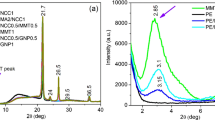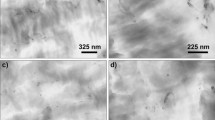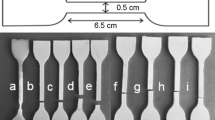Abstract
Low-density polyethylene/nano-magnesium hydroxide (LDPE/nano-Mg(OH)2) composites have been prepared by an in situ bubble stretching (ISBS) method and simple shear method. By means of field emission scanning electron microscopy (FE-SEM) and transmission electron microscopy (TEM), it was confirmed that the ISBS method leads to a high degree of dispersion of the Mg(OH)2 nanoparticles in the LDPE matrix. Furthermore, no significant re-aggregation of the nanoparticles was observed after removing the bubbles by means of high-speed grinding. The tensile strengths of nanocomposites prepared by means of the ISBS method were higher than those of materials with the same Mg(OH)2 loading produced by direct blending/extrusion. The tensile strength of the nanocomposites produced by the ISBS method reached a maximum value at an Mg(OH)2 content of 15 phr. In contrast, the tensile strength of composites prepared by direct blending/extrusion shows a monotonic decrease with increasing Mg(OH)2 content. The improvement in mechanical properties of nanocomposites associated with the use of the ISBS method can be attributed to a more homogeneous dispersion of smaller nanoparticles.






Similar content being viewed by others
References
Rong M, Zhang M, Zheng Y et al (2001) Improvement of tensile properties of nano-SiO2/PP composites in relation to percolation mechanism. Polymer 42(7):3301–3304
Agag T, Koga T, Takeichi T (2001) Studies on thermal and mechanical properties of polyimide-clay nanocomposites. Polymer 42(8):3399–3408
Shelley JS, Mather PT, De Vries KL (2001) Reinforcement and environmental degradation of nylon-6/clay nanocomposites. Polymer 42(13):5849–5858
Fu X, Qutubuddin S (2000) Synthesis of polystyrene-clay nanocomposites. Mater Lett 42:12–15
Shu Z, Chen G, Qi Z (2000) Polymer/clay nano-composite and its unique flame retardance. Plastics Industry 28(3):24–26
Uhl FM, Wilkie CA (2002) Polystyrene/graphite nanocomposites: effect on thermal stability. Polym Degrad Stab 76(1):111–122
Hornsby RP, Watson CL (1989) Mechanism of smoke suppression and fire retardancy in polymer containing magnesium hydroxide filler. Plast Rubber Process Appl (11):45–49
Chiu SH, Wang WK (1998) The dynamic flammability and toxicity of magnesium hydroxide filled intumescent fire retardant polypropylene. J Appl Polym Sci 67(6):989–995
Sain M, Park SH, Suhara F et al (2004) Flame retardant and mechanical properties of natural fiber-PP composites containing magnesium hydroxide. Polym Degrad Stab 83(2):363–367
Wu D, Meng Q, Liu Y et al (2003) In situ bubble-stretching dispersion mechanism for additives in polymers. J Polym Sci 41:1051–1058
Meng Q, Wu D (2004) A study of bubble inflation in polymers and its applications. Phys Lett A 327:61–66
Medellin-Rodriguez FJ, Burger C, Hsiao BS et al (2001) Time-resolved shear behavior of end-tethered nylon 6-clay nanocomposites followed by non-isothermal crystallization. Polymer 42(21):9015–9023
Yeh JM, Lion SJ, Lin CY et al (2002) Anticorrosively enhanced PMMA clay nanocomposite materials with quaternary alkylphosphonium salt as an intercalating agent. Chem Mater 14(1):154–161
Kawasumi M, Okada A (1997) Preparation and mechanical properties of polypropylene clay hybrids. Macromolecules 30(20):6333–6338
Zhang L, Wang Y, Wang Y et al (1998) Preparation and property of clay/SBR rubber nanocomposites. Special Purpose Rubber Products 19(2):6–9
Ma J, Qi Z, Zhang S (2001) Synthesis and characterization of elastomeric polyurethane/clay nanocomposites. J Appl Polym Sci 3:325–328
Tadmor Z, Gogos G (1979) Principles of polymer processing. Wiley, New York
Hee JY, Han CD (1982) AIChE J 28(6):1002–1008
Li T, Yin Q (1995) Ultrasonic chemistry. Science Press, Beijing
Leclair A, Favis BD (1996) The role of interfacial contact in immiscible binary polymer blends and its influence on mechanical properties. Polymer 37(21):4723–4728
Acknowledgements
This study was funded by a Key Scientific Research Project of the Chinese Ministry of Education (No. 104025) and the National Natural Science Foundation of China (No. 50673006).
Author information
Authors and Affiliations
Corresponding author
Rights and permissions
About this article
Cite this article
Zheng, Xt., Wu, Dm., Meng, Qy. et al. Mechanical properties of low-density polyethylene/nano-magnesium hydroxide composites prepared by an in situ bubble stretching method. J Polym Res 15, 59–65 (2008). https://doi.org/10.1007/s10965-007-9141-7
Received:
Accepted:
Published:
Issue Date:
DOI: https://doi.org/10.1007/s10965-007-9141-7




